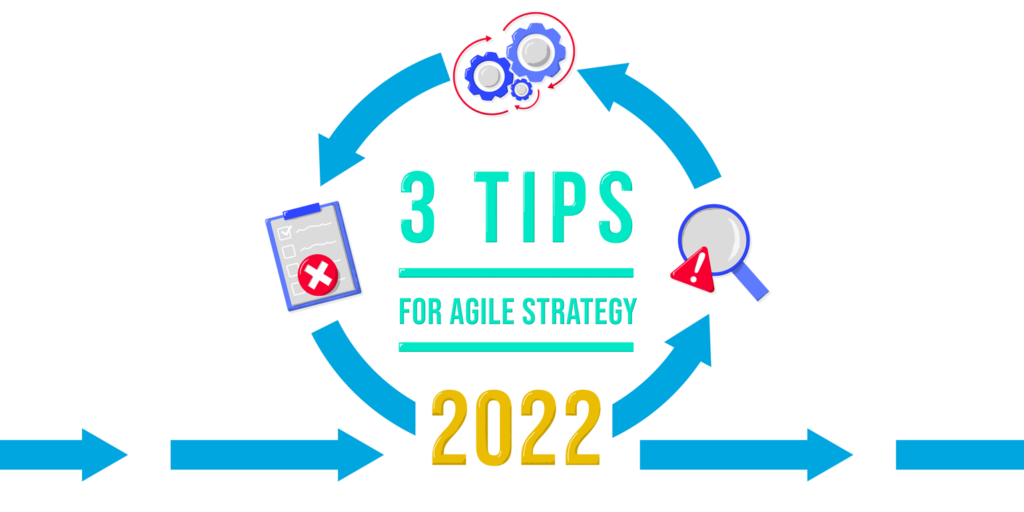Three Tips for Successful, Agile Strategy This Year
Thomas Edison famously said, “Vision without execution is just hallucination.” Chances are, as the new year gets underway, you’ve got a solid vision for what you want to accomplish within your organization. Whether or not you meet those goals will be determined largely by the actions taken to achieve them, and action without a plan – to quote another famous American – is just a speech.
One of the biggest trends in business performance right now is to transform processes in order to deliver faster, better and more efficiently. In a word, to be more agile. The ideal agile environment is able to create better results while using less resources, or at least using resources more efficiently. No matter the department, the effort to be agile must start with rethinking your approach to strategy.
To move out of the ‘hallucination’ phase and past the ‘inspired speeches’ rhetoric, it is critical that your strategy is set up for success. Below are three tips we’ve found that work for companies of all shapes and sizes, and help to set you on a more modern path of strategic action.
Create smaller plans more frequently
Even just a few years ago, strategic planning was considered at least an annual activity, if not every few years. Plans were designed in years-long increments and the enormity of work that went into them required months of effort from multiple stakeholders. That level of planning just doesn’t work in today’s business environment.
For companies to be successful now, and to be ready to adapt to market changes, competitor activities and customer demands, your team must be in a regular state of evaluation and execution. A more agile approach to strategy allows for greater flexibility and flow, and is more effective when created in shorter bursts of time – such as quarterly or even monthly plans.
The speed of agile strategy demands fewer layers of process and approval. It requires relinquishing control in some instances and empowering your teams to make strategic decisions faster, and it allows for a quicker change of direction if needed.
Ensure there is a well-oiled feedback loop
If you’re ready to embrace smaller, more frequent strategic plans you need to ensure your staff is empowered at all levels and prepared to adequately assess what is working and what is not. This demands a shift in company culture, one that can tolerate – perhaps even celebrate – missteps along the way.
By creating a disciplined feedback loop, one that is consistent, you can ensure you won’t go down a wrong path for too long without course correcting. If your plans are quarterly, for example, your feedback should at least be monthly or every few weeks. If you’ve got a one-month strategic plan, consider having a check in at least a few times a week.
These regular efforts at communicating as a team do not have to be formal, but the effort to make them happen should be. By listening to every level of the organization, you have a better chance at addressing disruptions quickly, ensuring you have the proper resources to achieve your goals, and creating those key elements that set you apart from the competition.
Be aware of risk, but don’t let it steal your focus
It can be tricky to know how to walk the line between innovation and creativity, and risk mitigation. Both are important to the success of the organization, but too much focus on one can impede the other.
Risk management is a necessary part of any strategic plan, but allowing risk considerations to loom large in front of you makes it nearly impossible to open the door to transformation, with its inherent challenges and potential failures. At StrategyBlocks, we help our customers put Risk Management in its proper place, by keeping the visibility of risks simple and straightforward and helping you to see how the success (or failure) of strategy can impact risk through our Strategic Health feature.
When you and your team feel that risk is properly assessed and managed, it allows for greater flexibility and creativity in working to meet goals. Using a visual strategy approach helps to see results in real time and learn lessons quickly, creating a more supportive environment that provides guardrails without stifling innovation.
Set yourself up now for success by investing in two critical elements of agile strategy: smarter processes and empowered people. Challenges will arise as they always do, but so will opportunities. For the year ahead, keep these predictions on your radar and let us help you and your organization succeed with a modern, agile strategic framework that meets the needs of your team now and in the future.




Leave A Comment